Sloths are small mammals famous for their low energy, extensive sleeping habit, long claws, and slow movement, moving only as far as 40 yards daily. The saying “as lazy as a sloth” was coined from the observation of these arboreal animals. Sloths weigh an average of 10 to 17 pounds and grow to a maximum length of about 31 inches.
However, in ancient times, sloths were quite different. Some were enormous and lived predominantly on land. A unique species of giant ground sloth was recorded to weigh up to four tons and stood at about 12 feet on its hind legs, making it as tall as a house. Let’s meet this extinct giant mammal.
Meet the Giant Ground Sloth: Megatherium Americanum
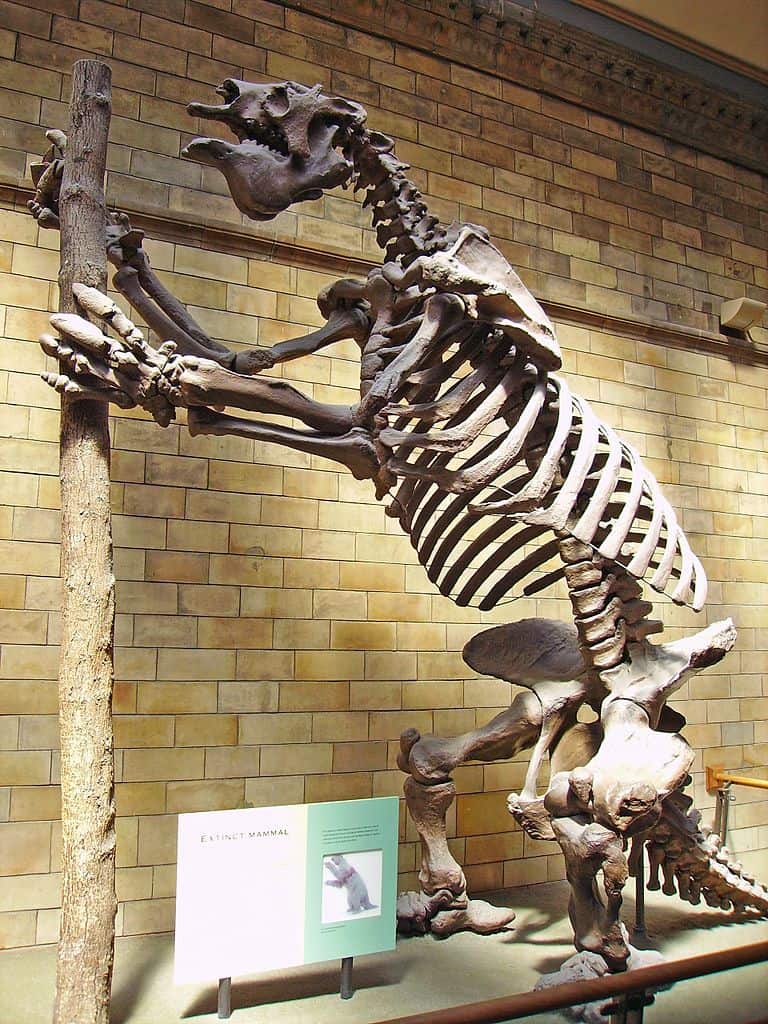
Megatherium americanum weighed up to four tons, thus earning the moniker “beast from America.”
©Ballista / CC BY-SA 3.0 – License
Megatherium is a genus of extinct giant ground sloths that belongs to the superorder Xenarthra which also includes tree sloths, armadillos, and anteaters. They are typified by strong thick bones and joints.
Megatherium americanum is the largest species of the extinct ground sloth genus. The name means “great beast from America.” This giant sloth lived in the Middle Pleistocene until the Holocene period. This elephant-sized animal weighed up to four tons, making it one of the heaviest animals worldwide, if it existed in the present day. It also had large claws that grew up to seven inches.
What Did Megatherium Americanum Look Like?
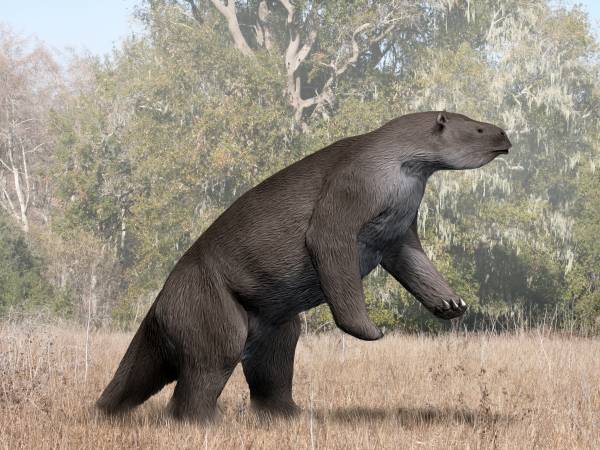
Megatherium americanum looked like a very large tree sloth with less hair and seven-inch long claws.
©Nobu Tamura email:[email protected] http://spinops.blogspot.com/ / CC BY-SA 4.0 – License
Ground sloths looked like modern tree sloths, with longer forelimbs than short hind limbs. Megatherium americanum was a massive, almost-hairless beast. Its length was about 20 feet from head to tail, but it stood at 12 feet on its hind legs. For an animal that large and robust, the giant sloth had a small head relative to its body size.
Due to the seven-inch long claws, it is believed that Megatherium americanum waddled when they walked. Therefore, they had to walk on four limbs to distribute their weight evenly. The heel and outside foot were responsible for carrying the massive weight of the ancient sloth.
What Did Megatherium Americanum Eat?
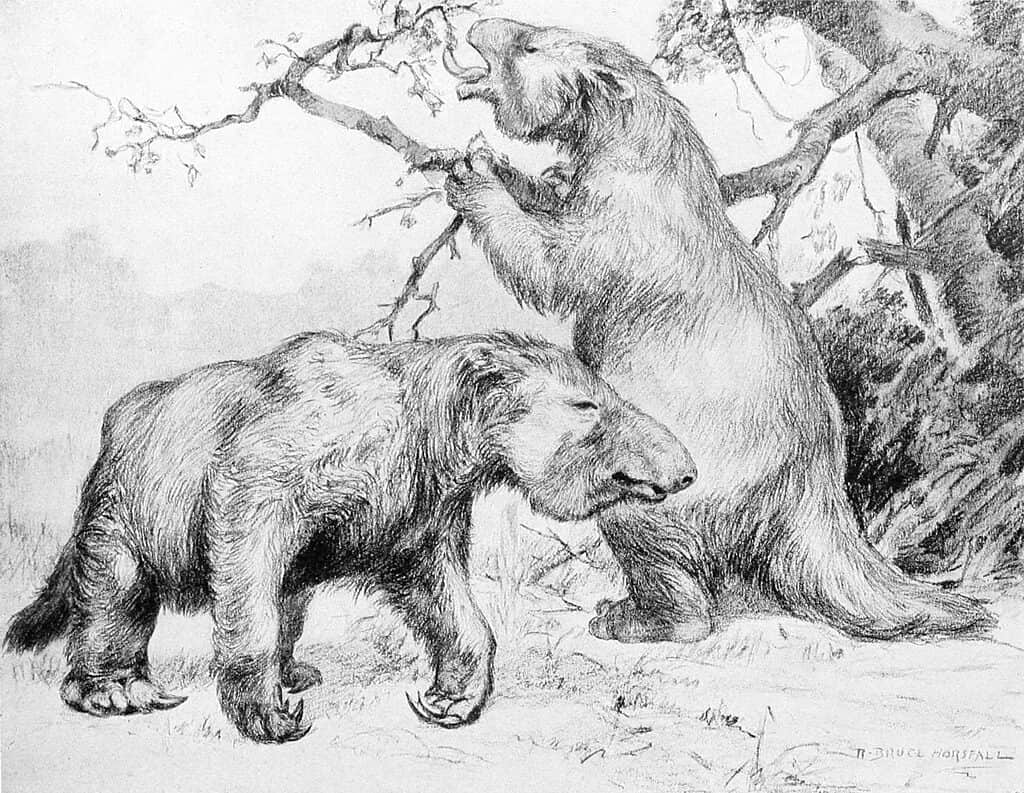
Megatherium americanum were herbivores that ate leaves and twigs.
©Robert Bruce Horsfall (1869–1948) / public domain – License
According to reports, Megatherium ground sloths were herbivores like their living descendants, the tree sloths. These giant sloths had narrow snouts and dentition, indicating a tough and fibrous diet. Also, Megatherium americanum had long claws with which they could easily tear tree branches. Standing on their hind feet, these giant sloths could have their pick of tree leaves.
However, it is believed that these giant sloths might have been picky eaters as they used their lips to feel for leaves before consuming them. They also had a unique tongue with which they could wrap around leaves.
Due to their size and strength, some scientists debated that Megatherium americanum might have been omnivores capable of eating meat. However, these giant sloths were slow and would have been outrun by numerous prey, and they were also too large to hide or sneak up on smaller animals. If these sloths did eat meat, it would have been carcasses, which they would not have had to hunt for.
Habitat: Where and When Megatherium Americanum Lived
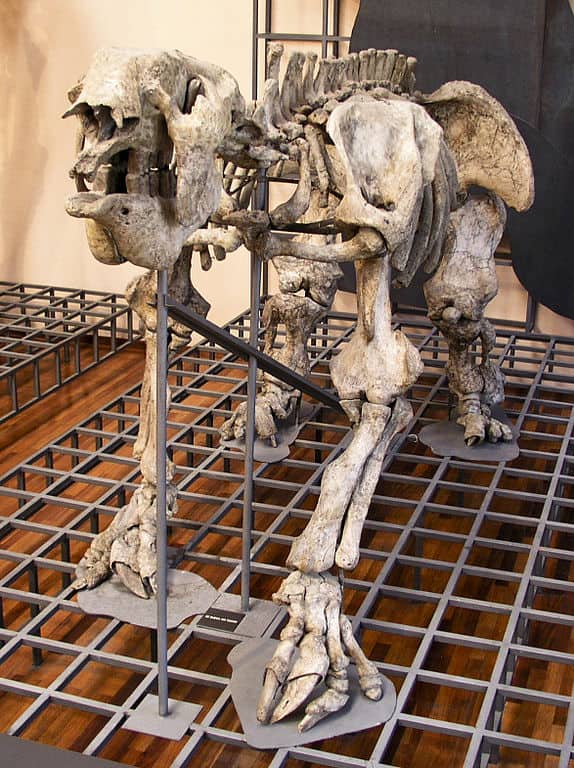
Megatherium americanum lived in South America between the Pleistocene and Holocene periods.
©Xauxa Håkan Svensson / CC BY-SA 3.0 – License
Megatherium americanum was endemic to South America when the continent was isolated. However, it is believed that they could have migrated into North America during the Pliocene period when South America was connected to North America by the Panamanian Land Bridge.
These large sloths lived in grasslands and woodlands, which were close to lakes. At night, they could also have slept in caves. Megatherium americanum lived between the Pleistocene and Holocene periods, between 400,000 and 8,000 years ago.
Threat and Predators: What Hunted Megatherium Americanum?

The major predator of the giant ground sloth was man.
©Marcus Burkhardt / CC BY 3.0 – License
Megatherium americanum might have been a herbivore, but it was so enormous and powerful that any singular predator would not have been able to bring one down. It was most likely one of the largest animals in its environment, even after the North and South American continents merged for a while. This introduced some carnivores to South America, while some animals endemic to the south migrated to North America.
However, it is believed that younger ground sloths could have fallen prey to dire wolves or saber-toothed tigers. They were still present when humans settled on both continents, introducing new predators to Megatherium americanum. According to reports, Megatherium americanum might not have been as sluggish as modern tree sloths, making them more difficult for humans to hunt down than tree sloths.
Discoveries and Fossils: Where Megatherium Americanum was Found
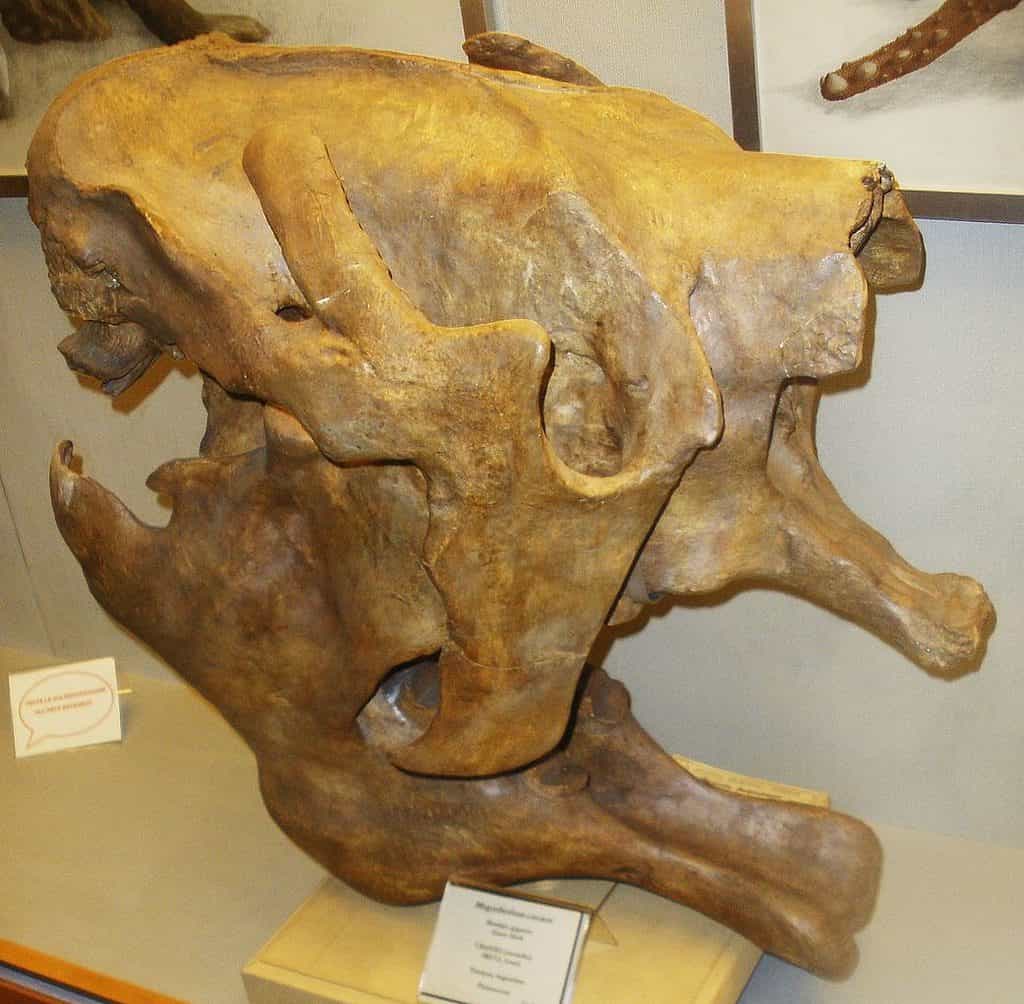
Fossils of Megatherium americanum were found in Argentina, Bolivia, and Uruguay.
©Ghedoghedo / CC BY-SA 3.0 – License
According to reports, the first Megatherium discovery was made in 1787 by Manuel Torres in Argentina. A young Charles Darwin found fossils of these giant sloths between 1832 and 1833. Other fossils of Megatherium americanum have been found in Argentina, Uruguay, and Bolivia, pointing to the theories that these large mammals were endemic to Southern and Central America.
Extinction: When Did Megatherium Die Out?

Scientists believe that Megatherium americanum started dying about 8,000 to 10,000 years ago.
©Fuzheado / CC0 1.0 – License
Scientists believe that Megatherium americanum became extinct because of human hunting and climate changes at the end of the Ice Age. The climate got warmer and wetter, and with it, the disappearances of the giant sloth’s food source. However, they are uncertain about the magnitude of the effects of human hunters on the extinction of the giant sloths. A site in Argentina revealed human butchery on the bones of this giant sloth, recorded about 12,600 years ago.
Fossil records indicate that these large ground sloths died about 8,000 to 10,000 years ago. The end of the Ice Age brought global climate change, giving way to heavily forested areas, amongst other changes. However, it is believed that some giant sloths might have survived much longer on the Caribbean islands, where they were isolated, and it took humans longer to reach and colonize those areas.
Is Megatherium the Largest Ground Sloth Ever?

With up to 80 different genera of ground sloths, Megatherium americanum is one of the two largest sloths ever.
©iStock.com/CoreyFord
Megatherium americanum, the giant ground sloth, weighed about 8,000 pounds, which is more than five times the size of a bear. However, it is one of up to 80 different genera of ground sloths assigned by paleontologists, which belong to seven families. Megatherium americanum was one of the few giant ground sloths, and its closest competition as the largest ground sloth ever is Eremotherium, which weighs roughly the same.
Eremotherium
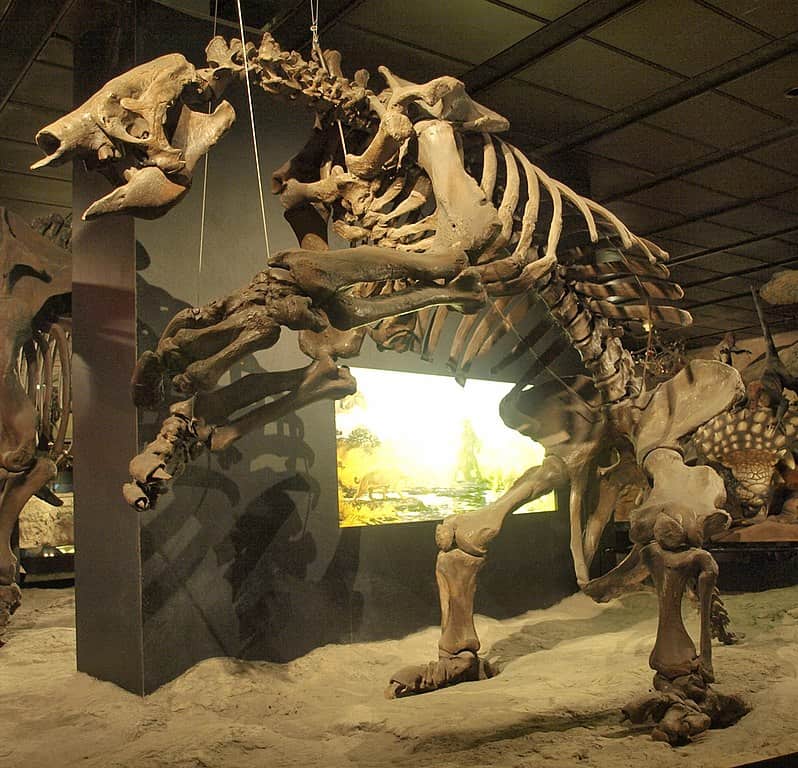
Eremotherium weighs as much as Megatherium but lived more extensively, reaching Mexico and the United States.
©Wikipedia Loves Art participant “Kamraman” / CC BY-SA 2.5 – License
According to the Guinness World Records, the title for the largest sloth ever is shared by both Eremotherium and Megatherium. They both weighed roughly four tons and had similar lengths. Despite their similar sizes, Eremotherium had longer limbs and a leaner skull.
They were mostly found in Brazil, Panama, Mexico, and even some states in America. Thus, Eremotherium earned the moniker “Pan-American giant ground sloth.”
Up Next:
New Study: Giant Carnivorous Sloth Once Roamed the Earth
Top 10 Heaviest Animals in the World
Why Did the Giant Sloth Go Extinct?
The 7 Weirdest Extinct Animals
Just How Big Was Giganotosaurus? Was It a T-rex Killer?
The photo featured at the top of this post is © Robert Bruce Horsfall (1869–1948) / public domain – License / Original
Sources
- , Available here: https://www.ncbi.nlm.nih.gov/pmc/articles/PMC3842198/
- Pip Brewer, Available here: http://www.nhm.ac.uk/discover/what-was-megatherium.html
- , Available here: https://www.guinnessworldrecords.de/world-records/93333-largest-sloth
- , Available here: http://www.sciencedaily.com/releases/2017/04/170418094855.htm
Thank you for reading! Have some feedback for us? Contact the AZ Animals editorial team.






